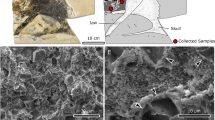Summary
The integumental melanophores of Latimeria chalumnae were studied by light and electron microscopy. The epidermal melanophore located in the mid-epidermis consists of a round perikaryon with long slender dendrites extending into epidermal cells and intercellular spaces. The dermal melanophores occur in the loose dermal matrix underlying a relatively thick layer of collagen fibers. The dermal melanophores are usually flattened and their dendrites lie parallel to the collagen layer. Both epidermal and dermal melanophores contain oval, electron-opaque melanosomes, large mitochondria, agranular vacuoles of endoplasmic reticulum and microtubules. Microfilaments and RNP particles are less conspicuous. While the peripheral cytoplasm of both dermal and epidermal melanophores is filled with a large number of melanosomes, the perinuclear cytoplasm of many dermal melanophores is occupied by premelanosomes in various stages of differentiation, and that of the epidermal melanophore contains numerous large vacuoles. Despite the scarcity of epidermal melanophores, the epidermal melanin unit is present in the form of melanosome complexes. In addition, the melanophores of Latimeria possess the basic characteristics common to other vertebrates, but they more closely resemble those of lungfish and other aquatic vertebrates.
Similar content being viewed by others
References
Bagnara, J.T.: Interrelationships of melanophores, iridophores, and xanthophores. In: Pigmentation: its genesis and biologic control. Riley, V., ed., p. 171–180. New York: Appleton-Century-Crofts 1972
Bikle, D., Tilney, L.G., Porter, K.R.: Microtubules and pigment migration in the melanophores of Fundulus heteroclitus L. Protoplasma 61, 322–345 (1966)
Breathnach, A.S., Poyntz, S.V.: Electron microscopy of pigment cells in tail skin of Lacerta vivipara. J. Anat. (Lond.) 110, 549–569 (1966)
Fitzpatrick, T.B., Quevedo, W.C., Jr., Levene, A.L., McGovern, V.J., Mishima, Y., Oettle, A.G.: Terminology of vertebrate melanin-containing cells: 1965. Science 152, 88–89 (1966)
Green, L.: Mechanism of movements of granules in melanophores of Fundulus heteroclitus. Proc. nat. Acad. Sci. (Wash.) 59, 1179–1186 (1968)
Hadley, C.E.: Color changes in excised pieces of the integument of Anolis equestris under the influence of light. Proc. nat. Acad. Sci. (Wash.) 14, 822–824 (1928)
Hadley, C.E.: Color changes in excised and intact reptilian skin. J. exp. Zool. 58, 321–331 (1931)
Hadley, M.E., Quevedo, W.C., Jr.: Vertebrate epidermal melanin unit. Nature (Lond.) 209, 1334–1335 (1966)
Imaki, H., Chavin, W.: Ultrastructure of the integumental melanophores of the Australian lungfish, Neoceratodus forsteri. Cell Tiss. Res. 158, 365–373 (1975a)
Imaki, H., Chavin, W.: Ultrastructure of the integumental melanophores of the South American lungfish (Lepidosiren paradoxa) and the African lungfish (Protopterus sp.). Cell Tiss. Res. 158, 375–389 (1975b)
Jande, S.S.: Fine structure of tadpole melanophores. Anat. Rec. 154, 533–544 (1966)
Jimbow, K., Kukita, A.: Fine structure of pigment granules in the human hair bulb: ultrastructure of pigment granules. In: Biology of normal and abnormal melanocytes. Kawamura, T., Fitzpatrick, T.B., and Seiji, M., eds., p. 171–193. Baltimore: University Park Press 1971
Junqueira, L.C., Raker, E., Porter, K.R.: Studies on pigment migration in the melanophores of the teleost Fundulus heteroclitus (L). Arch. Histol. Jap. 36, 339–366 (1974)
Locket, N.A., Griffith, R.W.: Observation on a living coelacanth. Nature (Lond.) 237, 175 (1972)
Obika, M., Bagnara, J.T.: Photic influences on Xenopus melanophores in tissue culture. Amer. Zool., 495 (Abstract) (1963)
Oguri, M., Omura, Y.: Ultrastructure and functional significance of the pineal organ of teleost. In: Responses of fish to environmental changes. Chavin, W., ed., p. 412–434. Springfield: Charles C. Thomas Publisher 1973
Rüdeberg, C.: Structure of the pineal organ of the sardine, Sardina pilchardus sardina (Risso), and some further remarks on the pineal organ of Mugil spp. Z. Zellforsch. 84, 219–237 (1968a)
Rüdeberg, C.: Receptor cells in the pineal organ of the dogfish Scyliorhinus canicula Linné. Z. Zellforsch. 85, 521–526 (1968b)
Seiji, M., Shimao, K., Birbeck, M.S.C., Fitzpatrick, T.B.: Subcellular localization of melanin biosynthesis. Ann. N.Y. Acad. Sci. 100, 497–533 (1963)
Taylor, J.D.: The presence of reflecting platelets in integumental melanophores of the frog, Hyla arenicolor. J. Ultrastruct. Res. 35, 532–540 (1971)
Wise, G.E.: Ultrastructure of amphibian melanophores after light-dark adaptation and hormonal treatment. J. Ultrastruct. Res. 27, 472–485 (1969)
Author information
Authors and Affiliations
Additional information
Contribution Number 350, Department of Biology.
Rights and permissions
About this article
Cite this article
Imaki Lamer, H., Chavin, W. Ultrastructure of the integumental melanophores of the coelacanth, Latimeria chalumnae . Cell Tissue Res. 163, 383–394 (1975). https://doi.org/10.1007/BF00219472
Received:
Issue Date:
DOI: https://doi.org/10.1007/BF00219472




